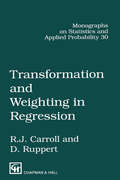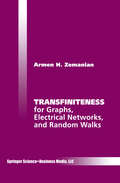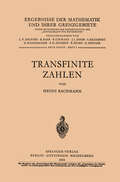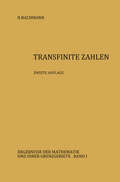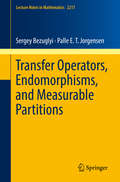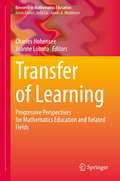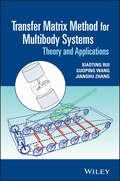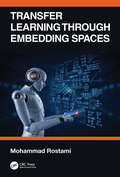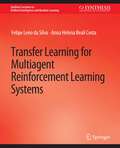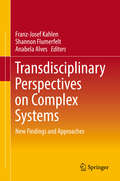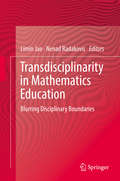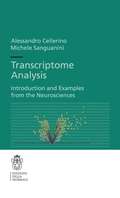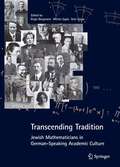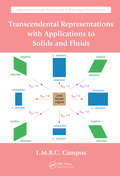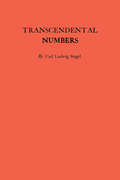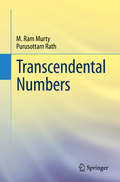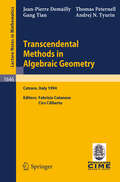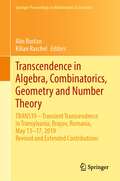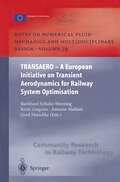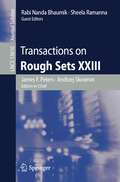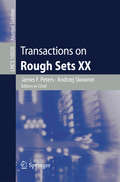- Table View
- List View
Transformation - Enlargement of a Triangle (tactile)
by RnibThis diagram shows how a triangle can be transformed over a grid to be enlarged.
Transformation and Weighting in Regression
by David Ruppert Raymond J. CarrollThis monograph provides a careful review of the major statistical techniques used to analyze regression data with nonconstant variability and skewness. The authors have developed statistical techniques--such as formal fitting methods and less formal graphical techniques-- that can be applied to many problems across a range of disciplines, including pharmacokinetics, econometrics, biochemical assays, and fisheries research.While the main focus of the book in on data transformation and weighting, it also draws upon ideas from diverse fields such as influence diagnostics, robustness, bootstrapping, nonparametric data smoothing, quasi-likelihood methods, errors-in-variables, and random coefficients. The authors discuss the computation of estimates and give numerous examples using real data. The book also includes an extensive treatment of estimating variance functions in regression.
Transformation and Weighting in Regression
by David Ruppert Raymond J. CarrollThis monograph provides a careful review of the major statistical techniques used to analyze regression data with nonconstant variability and skewness. The authors have developed statistical techniques--such as formal fitting methods and less formal graphical techniques-- that can be applied to many problems across a range of disciplines, including pharmacokinetics, econometrics, biochemical assays, and fisheries research.While the main focus of the book in on data transformation and weighting, it also draws upon ideas from diverse fields such as influence diagnostics, robustness, bootstrapping, nonparametric data smoothing, quasi-likelihood methods, errors-in-variables, and random coefficients. The authors discuss the computation of estimates and give numerous examples using real data. The book also includes an extensive treatment of estimating variance functions in regression.
Transfiniteness: For Graphs, Electrical Networks, and Random Walks
by Armen H. Zemanian"What good is a newborn baby?" Michael Faraday's reputed response when asked, "What good is magnetic induction?" But, it must be admitted that a newborn baby may die in infancy. What about this one- the idea of transfiniteness for graphs, electrical networks, and random walks? At least its bloodline is robust. Those subjects, along with Cantor's transfinite numbers, comprise its ancestry. There seems to be general agreement that the theory of graphs was born when Leonhard Euler published his solution to the "Konigsberg bridge prob lem" in 1736 [8]. Similarly, the year of birth for electrical network theory might well be taken to be 184 7, when Gustav Kirchhoff published his volt age and current laws [ 14]. Ever since those dates until just a few years ago, all infinite undirected graphs and networks had an inviolate property: Two branches either were connected through a finite path or were not connected at all. The idea of two branches being connected only through transfinite paths, that is, only through paths having infinitely many branches was never invoked, or so it appears from a perusal of various surveys of infinite graphs [17], [20], [29], [32]. Our objective herein is to explore this idea and some of its ramifications. It should be noted however that directed graphs having transfinite paths have appeared in set theory [6, Section 4.
Transfinite Zahlen (Ergebnisse der Mathematik und ihrer Grenzgebiete. 2. Folge #1)
by Heinz BachmannDer vorliegende Bericht soll dem Leser die Ergebnisse und Probleme der Theorie der transfiniten Zahlen (Ordnungszahlen und Mächtigkeiten) nach ihrem heutigen Stande vermitteln, wobei die arithmetischen Fragen ziemlich erschöpfend erörtert werden, während auf axiomatische Fra gen weniger stark eingegangen wird. Die Grundlage bildet dabei das ZERMELO-FRAENKELsche Axiomensystem der Mengenlehre; die Anwen dung des Auswahlaxioms wird stets hervorgehoben. Um die Beschränkung auf einen bestimmten Formalismus zu vermeiden und zwecks besserer Lesbarkeit ist alles in der Sprache der naiven Mengenlehre formuliert. Nach einer allgemeinen Einleitung findet der Leser eine Darstellung der Theorie der Ordnungszahlen, wobei das Auswahlaxiom nur in Aus nahmefällen verwendet wird. Die neuen Ergebnisse über Normalfunktionen (§§7, 16) und über regressive Funktionen (§ 9) sowie die einfache Dar stellung der Theorie der Hauptzahlen (§§ 15,16) dürften dabei besonders von Interesse sein. Sodann folgt die Theorie der Mächtigkeiten; zuerst wird gezeigt, welche ersten Schritte in dieser Theorie ohne Auswahlaxiom ausgeführt werden können; dann wird die Theorie unter Verwendung des Auswahlaxioms (und ausführlicher) weiter entwickelt. Den Äquivalenzen zum Auswahlaxiom (§ 31) und zur Alephhypothese (§ 35) sowie den un erreichbaren Zahlen (§§ 40-42) wird besondere Beachtung geschenkt. Auf das Problem der formalen Darstellung von Ordnungszahlen, auf Anwen dungen der transfiniten Zahlen in der Theorie der Punktmengen und andere Anwendungen konnte wegen des beschränkten zur Verfügung stehenden Raumes nicht stark eingegangen werden. Am Scllluß findet sich ein Literaturverzeichnis, in dem die modernen Arbeiten fast voll ständig, die älteren nur teilweise aufgeführt sind, sowie ein Sachver zeichnis.
Transfinite Zahlen (Ergebnisse der Mathematik und ihrer Grenzgebiete. 2. Folge #1)
by Heinz BachmannTransfer Operators, Endomorphisms, and Measurable Partitions (Lecture Notes in Mathematics #2217)
by Sergey Bezuglyi Palle E. JorgensenThe subject of this book stands at the crossroads of ergodic theory and measurable dynamics. With an emphasis on irreversible systems, the text presents a framework of multi-resolutions tailored for the study of endomorphisms, beginning with a systematic look at the latter. This entails a whole new set of tools, often quite different from those used for the “easier” and well-documented case of automorphisms. Among them is the construction of a family of positive operators (transfer operators), arising naturally as a dual picture to that of endomorphisms. The setting (close to one initiated by S. Karlin in the context of stochastic processes) is motivated by a number of recent applications, including wavelets, multi-resolution analyses, dissipative dynamical systems, and quantum theory. The automorphism-endomorphism relationship has parallels in operator theory, where the distinction is between unitary operators in Hilbert space and more general classes of operators such as contractions. There is also a non-commutative version: While the study of automorphisms of von Neumann algebras dates back to von Neumann, the systematic study of their endomorphisms is more recent; together with the results in the main text, the book includes a review of recent related research papers, some by the co-authors and their collaborators.
Transfer of Learning: Progressive Perspectives for Mathematics Education and Related Fields (Research in Mathematics Education)
by Charles Hohensee Joanne LobatoThis book provides a common language for and makes connections between transfer research in mathematics education and transfer research in related fields. It generates renewed excitement for and increased visibility of transfer research, by showcasing and aggregating leading-edge research from the transfer research community. This book also helps to establish transfer as a sub-field of research within mathematics education and extends and refines alternate perspectives on the transfer of learning. The book provides an overview of current knowledge in the field as well as informs future transfer research.
Transfer Matrix Method for Multibody Systems: Theory and Applications
by Xiaoting Rui Guoping Wang Jianshu ZhangTRANSFER MATRIX METHOD FOR MULTIBODY SYSTEMS: THEORY AND APPLICATIONS Xiaoting Rui, Guoping Wang and Jianshu Zhang - Nanjing University of Science and Technology, China Featuring a new method of multibody system dynamics, this book introduces the transfer matrix method systematically for the first time. First developed by the lead author and his research team, this method has found numerous engineering and technological applications. Readers are first introduced to fundamental concepts like the body dynamics equation, augmented operator and augmented eigenvector before going in depth into precision analysis and computations of eigenvalue problems as well as dynamic responses. The book also covers a combination of mixed methods and practical applications in multiple rocket launch systems, self-propelled artillery as well as launch dynamics of on-ship weaponry. • Comprehensively introduces a new method of analyzing multibody dynamics for engineers • Provides a logical development of the transfer matrix method as applied to the dynamics of multibody systems that consist of interconnected bodies • Features varied applications in weaponry, aeronautics, astronautics, vehicles and robotics Written by an internationally renowned author and research team with many years' experience in multibody systems Transfer Matrix Method of Multibody System and Its Applications is an advanced level text for researchers and engineers in mechanical system dynamics. It is a comprehensive reference for advanced students and researchers in the related fields of aerospace, vehicle, robotics and weaponry engineering.
Transfer Matrix Method for Multibody Systems: Theory and Applications
by Xiaoting Rui Guoping Wang Jianshu ZhangTRANSFER MATRIX METHOD FOR MULTIBODY SYSTEMS: THEORY AND APPLICATIONS Xiaoting Rui, Guoping Wang and Jianshu Zhang - Nanjing University of Science and Technology, China Featuring a new method of multibody system dynamics, this book introduces the transfer matrix method systematically for the first time. First developed by the lead author and his research team, this method has found numerous engineering and technological applications. Readers are first introduced to fundamental concepts like the body dynamics equation, augmented operator and augmented eigenvector before going in depth into precision analysis and computations of eigenvalue problems as well as dynamic responses. The book also covers a combination of mixed methods and practical applications in multiple rocket launch systems, self-propelled artillery as well as launch dynamics of on-ship weaponry. • Comprehensively introduces a new method of analyzing multibody dynamics for engineers • Provides a logical development of the transfer matrix method as applied to the dynamics of multibody systems that consist of interconnected bodies • Features varied applications in weaponry, aeronautics, astronautics, vehicles and robotics Written by an internationally renowned author and research team with many years' experience in multibody systems Transfer Matrix Method of Multibody System and Its Applications is an advanced level text for researchers and engineers in mechanical system dynamics. It is a comprehensive reference for advanced students and researchers in the related fields of aerospace, vehicle, robotics and weaponry engineering.
Transfer Learning through Embedding Spaces
by Mohammad RostamiRecent progress in artificial intelligence (AI) has revolutionized our everyday life. Many AI algorithms have reached human-level performance and AI agents are replacing humans in most professions. It is predicted that this trend will continue and 30% of work activities in 60% of current occupations will be automated. This success, however, is conditioned on availability of huge annotated datasets to training AI models. Data annotation is a time-consuming and expensive task which still is being performed by human workers. Learning efficiently from less data is a next step for making AI more similar to natural intelligence. Transfer learning has been suggested a remedy to relax the need for data annotation. The core idea in transfer learning is to transfer knowledge across similar tasks and use similarities and previously learned knowledge to learn more efficiently. In this book, we provide a brief background on transfer learning and then focus on the idea of transferring knowledge through intermediate embedding spaces. The idea is to couple and relate different learning through embedding spaces that encode task-level relations and similarities. We cover various machine learning scenarios and demonstrate that this idea can be used to overcome challenges of zero-shot learning, few-shot learning, domain adaptation, continual learning, lifelong learning, and collaborative learning.
Transfer Learning through Embedding Spaces
by Mohammad RostamiRecent progress in artificial intelligence (AI) has revolutionized our everyday life. Many AI algorithms have reached human-level performance and AI agents are replacing humans in most professions. It is predicted that this trend will continue and 30% of work activities in 60% of current occupations will be automated. This success, however, is conditioned on availability of huge annotated datasets to training AI models. Data annotation is a time-consuming and expensive task which still is being performed by human workers. Learning efficiently from less data is a next step for making AI more similar to natural intelligence. Transfer learning has been suggested a remedy to relax the need for data annotation. The core idea in transfer learning is to transfer knowledge across similar tasks and use similarities and previously learned knowledge to learn more efficiently. In this book, we provide a brief background on transfer learning and then focus on the idea of transferring knowledge through intermediate embedding spaces. The idea is to couple and relate different learning through embedding spaces that encode task-level relations and similarities. We cover various machine learning scenarios and demonstrate that this idea can be used to overcome challenges of zero-shot learning, few-shot learning, domain adaptation, continual learning, lifelong learning, and collaborative learning.
Transfer Learning for Multiagent Reinforcement Learning Systems (Synthesis Lectures on Artificial Intelligence and Machine Learning)
by Felipe Felipe Leno da Silva Anna Helena Anna Helena Reali CostaLearning to solve sequential decision-making tasks is difficult. Humans take years exploring the environment essentially in a random way until they are able to reason, solve difficult tasks, and collaborate with other humans towards a common goal. Artificial Intelligent agents are like humans in this aspect. Reinforcement Learning (RL) is a well-known technique to train autonomous agents through interactions with the environment. Unfortunately, the learning process has a high sample complexity to infer an effective actuation policy, especially when multiple agents are simultaneously actuating in the environment. However, previous knowledge can be leveraged to accelerate learning and enable solving harder tasks. In the same way humans build skills and reuse them by relating different tasks, RL agents might reuse knowledge from previously solved tasks and from the exchange of knowledge with other agents in the environment. In fact, virtually all of the most challenging tasks currently solved by RL rely on embedded knowledge reuse techniques, such as Imitation Learning, Learning from Demonstration, and Curriculum Learning. This book surveys the literature on knowledge reuse in multiagent RL. The authors define a unifying taxonomy of state-of-the-art solutions for reusing knowledge, providing a comprehensive discussion of recent progress in the area. In this book, readers will find a comprehensive discussion of the many ways in which knowledge can be reused in multiagent sequential decision-making tasks, as well as in which scenarios each of the approaches is more efficient. The authors also provide their view of the current low-hanging fruit developments of the area, as well as the still-open big questions that could result in breakthrough developments. Finally, the book provides resources to researchers who intend to join this area or leverage those techniques, including a list of conferences, journals, and implementation tools. This book will be useful for a wide audience; and will hopefully promote new dialogues across communities and novel developments in the area.
Transdisciplinary Perspectives on Complex Systems: New Findings and Approaches
by Franz-Josef Kahlen Shannon Flumerfelt Anabela AlvesThis book presents an internationally comprehensive perspective into the field of complex systems. It explores the challenges of and approaches to complexity from a broad range of disciplines, including big data, health care, medicine, mathematics, mechanical and systems engineering, air traffic control and finance. The book’s interdisciplinary character allows readers to identify transferable and mutually exclusive lessons learned among these disciplines and beyond. As such, it is well suited to the transfer of applications and methodologies between ostensibly incompatible disciplines. This book provides fresh perspectives on comparable issues of complexity from the top minds on systems thinking.
Transdisciplinarity in Mathematics Education: Blurring Disciplinary Boundaries
by Limin Jao Nenad RadakovicThe book explores various facets of transdisciplinarity in mathematics education and its importance for research and practice. The book comprehensively outlines the ways that mathematics interacts with different disciplines, world views, and contexts; these topics include: mathematics and the humanities, the complex nature of mathematics education, mathematics education and social contexts, and more. It is an invaluable resource for mathematics education students, researchers, and practitioners seeking to incorporate transdisciplinarity into their own practice.
Transcriptome Analysis: Introduction and Examples from the Neurosciences (Publications of the Scuola Normale Superiore #17)
by Alessandro Cellerino Michele SanguaniniThe goal of this book is to be an accessible guide for undergraduate and graduate students to the new field of data-driven biology. Next-generation sequencing technologies have put genome-scale analysis of gene expression into the standard toolbox of experimental biologists. Yet, biological interpretation of high-dimensional data is made difficult by the lack of a common language between experimental and data scientists. By combining theory with practical examples of how specific tools were used to obtain novel insights in biology, particularly in the neurosciences, the book intends to teach students how to design, analyse, and extract biological knowledge from transcriptome sequencing experiments.Undergraduate and graduate students in biomedical and quantitative sciences will benefit from this text as well as academics untrained in the subject.
Transcending Tradition: Jewish Mathematicians in German Speaking Academic Culture
by Birgit BergmannA companion publication to the international exhibition "Transcending Tradition: Jewish Mathematicians in German-Speaking Academic Culture", the catalogue explores the working lives and activities of Jewish mathematicians in German-speaking countries during the period between the legal and political emancipation of the Jews in the 19th century and their persecution in Nazi Germany. It highlights the important role Jewish mathematicians played in all areas of mathematical culture during the Wilhelmine Empire and the Weimar Republic, and recalls their emigration, flight or death after 1933.
Transcendental Representations with Applications to Solids and Fluids
by Luis Manuel Braga da Costa CamposBuilding on the author's previous book in the series, Complex Analysis with Applications to Flows and Fields (CRC Press, 2010), Transcendental Representations with Applications to Solids and Fluids focuses on four infinite representations: series expansions, series of fractions for meromorphic functions, infinite products for functions with infinit
Transcendental Numbers. (AM-16)
by Carl Ludwig SiegelThe description for this book, Transcendental Numbers. (AM-16), will be forthcoming.
Transcendental Numbers
by M. Ram Murty Purusottam RathThis book provides an introduction to the topic of transcendental numbers for upper-level undergraduate and graduate students. The text is constructed to support a full course on the subject, including descriptions of both relevant theorems and their applications. While the first part of the book focuses on introducing key concepts, the second part presents more complex material, including applications of Baker’s theorem, Schanuel’s conjecture, and Schneider’s theorem. These later chapters may be of interest to researchers interested in examining the relationship between transcendence and L-functions. Readers of this text should possess basic knowledge of complex analysis and elementary algebraic number theory.
Transcendental Methods in Algebraic Geometry: Lectures given at the 3rd Session of the Centro Internazionale Matematico Estivo (C.I.M.E.), held in Cetraro, Italy, July 4-12, 1994 (Lecture Notes in Mathematics #1646)
by Jean-Pierre Demailly Thomas Peternell Gang Tian Andrej N. TyurinTranscendence in Algebra, Combinatorics, Geometry and Number Theory: TRANS19 – Transient Transcendence in Transylvania, Brașov, Romania, May 13–17, 2019, Revised and Extended Contributions (Springer Proceedings in Mathematics & Statistics #373)
by Alin Bostan Kilian RaschelThis proceedings volume gathers together original articles and survey works that originate from presentations given at the conference Transient Transcendence in Transylvania, held in Brașov, Romania, from May 13th to 17th, 2019. The conference gathered international experts from various fields of mathematics and computer science, with diverse interests and viewpoints on transcendence. The covered topics are related to algebraic and transcendental aspects of special functions and special numbers arising in algebra, combinatorics, geometry and number theory. Besides contributions on key topics from invited speakers, this volume also brings selected papers from attendees.
TRANSAERO: A European Initiative on Transient Aerodynamics for Railway System Optimisation (Notes on Numerical Fluid Mechanics and Multidisciplinary Design #79)
by Burkhard Schulte-Werning Remi Gregoire Antonio Malfatti Gerd MatschkeThis volume entitled "TRANSAERO - A European Initiative on Transient Aerodynamics for Railway System Optimisation" contains the results of the contributors during the project th symposium which took place in Paris, France, on 4th and 5 May 1999 hosted by the International Union of Railways, UIC. This symposium was organised within the framework of the BRITE/EURAM project "TRANSAERO" under contract BRPR-CT9S-0067. The project has been co-financed by the European Union within the Fourth Research Framework Programme. More than 100 participants followed the invitation to the symposium. This great response shows the continuing interest in a relevant topic of railway technology and offered us the opportunity to present the recent results of intense European collaboration to the international community of railway aerodynamic experts. In the last few decades, mobility in Europe, based on automobiles for individual traffic and lorries for freight traffic, has grown more and more; yearly growth rates of more than 10% have often been reported by statistics. Even with a fully developed construction programme for motorways and similar high-performance roads, these growth rates cumulated over the years cannot easily be handled in an environment-friendly way. The European Commission has therefore given distinct political signals to get more passengers onto the railways. This policy represents a clear challenge for the next few decades for European railway companies: the considerable increase in mobility in a Europe with falling borders will cause a doubling of the traffic volume within the next 10 to 20 years.
Transactions on Rough Sets XXIII (Lecture Notes in Computer Science #13610)
by James F. Peters Andrzej Skowron Rabi Nanda Bhaumik Sheela RamannaThe LNCS journal Transactions on Rough Sets is devoted to the entire spectrum of rough sets related issues, from logical and mathematical foundations, through all aspects of rough set theory and its applications, such as data mining, knowledge discovery, and intelligent information processing, to relations between rough sets and other approaches to uncertainty, vagueness, and incompleteness, such as fuzzy sets and theory of evidence. Volume XXIII in the series is a continuation of a number of research streams that have grown out of the seminal work of Zdzislaw Pawlak during the first decade of the 21st century.
Transactions on Rough Sets XX (Lecture Notes in Computer Science #10020)
by James F. Peters Andrzej SkowronThe LNCS journal Transactions on Rough Sets is devoted to the entire spectrum of rough sets related issues, from logical and mathematical foundations, through all aspects of rough set theory and its applications, such as data mining, knowledge discovery, and intelligent information processing, to relations between rough sets and other approaches to uncertainty, vagueness, and incompleteness, such as fuzzy sets and theory of evidence. Volume XX in the series is a continuation of a number of research streams that have grown out of the seminal work of Zdzislaw Pawlak during the first decade of the 21st century.

